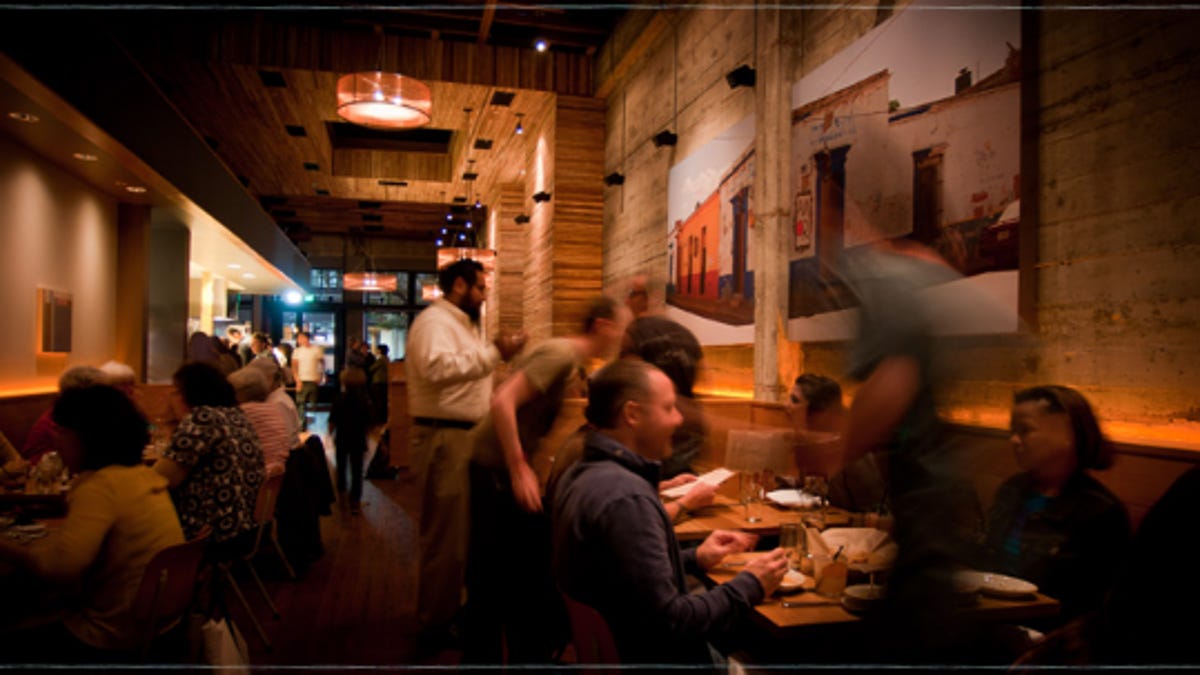Quieting the dinner din with a high-tech sound system
Intent on creating a chitchat-friendly environment, a restaurateur uses cutting-edge technology to control noise levels with the press of a button.

Besides bad service, too much noise is the biggest complaint people have about eating out, according to reviews site Zagat. And I agree. While a hip, happening place is fun for a single cocktail, it can be maddening, not to mention headache-inducing, when it comes to sustaining a dinner conversation.
Restaurateur John Paluska concurs: "Not being able to carry on a conversation in a restaurant that I was enjoying was really frustrating," he said, adding that it would be a conflicting experience. Even though he liked the place, he wasn't sure he'd want to go back "because I felt exhausted and had a really hard time carrying on a conversation when I was there," he said.
When Paluska decided to open his own restaurant in downtown Berkeley, Calif., designing a chitchat-friendly acoustic environment was one of the top priorities. "More and more restaurants are getting built in spaces that have a lot of hard, reflective surfaces, and there's not a lot of thought put into the sonic environment of the space," he says.
Through his architects, Abueg Morris, this former manager for the band Phish connected with John Meyer of Meyer Sound, also in Berkeley. Together the two of them created a unique recipe for controlling the sound, relying on some classic techniques with an added splash of the experimental. The result is the Mexican restaurant Comal, where conversation flows as easily as the tequila cocktails shaken at the bar.
The first step to achieving sonic harmony was to "dampen" the restaurant to take away the cavelike echoes. To do that, the lower portion of the walls were layered with tectum, a sound-absorbing material, and then covered with decorative burlap from old coffee sacks. Tectum also covers the upper walls above the exposed kitchen. Because it wouldn't look particularly stylish or welcoming to cover the entire restaurant with tectum, the team had to think creatively with their wall art to make it not just look good, but also help with the sound absorption. Meyer describes a high-tech kind of art canvas: "It's a special kind of fabric that can hold tension so it'll stay stiff and not relax and wrinkle. At the same time, it's porous enough that sound can go through it and won't reflect or bounce off of it." One large panel depicts a photograph of a Oaxacan street scene printed on this canvas, wrapped over recycled denim for double duty absorption. "Most people when they walk in here don't think, oh this place has been heavily treated for acoustics. It's not obvious. Most of the acoustic treatments here are fairly invisible and look decorative," adds Paluska. Comal's real acoustic wizardry comes from an innovative system of more than 120 speakers and microphones. The mics pick up the sound from the dining room and then send it for processing through servers in the basement. Paluska and his team can then use Meyer Sound's proprietary iOS app "Constellation" on their iPads or iPhones during the dinner service to control the sound through carefully pointed speakers. No part of a conversation is recorded, but the buzz is replayed with a longer echo to create a fuller-sounding space if the restaurant is empty, and with a shorter echo if it's already humming with a packed house. "There's a little bit of cognitive dissonance where you look around and you hear all this noise and think, I'm not going to be able to have a conversation. Then you sit down and realize there's this little bubble around you," says Paluska. "There's never been a physical solution found for restaurants that really satisfies both isolating yourself from everybody and at the same time, still being in a place that sounds like it's a restaurant, rather than a booth," adds Meyer. Since Comal has been open only a few months, it's too early to gauge if the heavy investment in this sound tech has paid off. But Paluska says he considers it a success every time he sees a table of guests linger or come back for a repeat visit.
